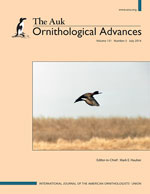Carotenoid coloration has been repeatedly shown to serve as a sexually selected signal of individual quality. Across different species, individuals showing brighter carotenoid-based signals have been found to have superior foraging abilities, to recover faster from diseases and, in general, to enjoy a better body condition. Experiments with birds have also shown that carotenoid supplementation can enhance flight performance, allowing birds to take off faster from the ground. Healthy, agile individuals should be better prepared to avoid predators, so it could be expected that individuals displaying brighter carotenoid-based coloration would show a higher escape ability from predator attacks. To test this prediction, we measured the escape ability of male House Finches (Haemorhous mexicanus) from a human with a net in a large aviary and related the escape ability of each individual to its breast coloration. Males with redder feathers showed a higher individual ability to escape than duller individuals. The superior flight performance of redder birds would be an important asset in escape from predators, as well as when foraging or maintaining a territory. In the specific case of the House Finch, the higher escape ability of redder individuals could be the reason for their higher overwinter survival rate.
How to translate text using browser tools
16 April 2014
Carotenoid coloration predicts escape performance in the House Finch (Haemorhous mexicanus)
Fernando Mateos-Gonzalez,
Geoffrey Hill,
Wendy Hood
ACCESS THE FULL ARTICLE

The Auk
Vol. 131 • No. 3
July 2014
Vol. 131 • No. 3
July 2014
aerobic capacity
condition
escape ability
Haemorhous mexicanus
predation
sexual selection




